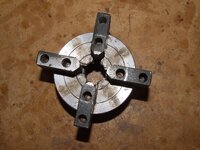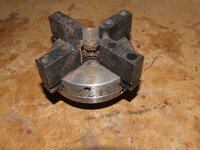medemt
Member
I am very new to turning pens and I am having a bit of trouble getting the hole drilled straight through the blanks. I figured this would be a no brainer since I went out and bought all the right equipment. Let me tell you what I am doing and if somone has a suggestion or a better way to be consistent, I am very much open.
First off I am using a drill press for the drilling. I know the bit is square with the table as I have checked it. I was drilling Bolivian Redwood with a 7 mm point bit. I put the blank inside a centering vise that I bought from CSUSA. The blanks are for slimline pens. I was drilling two different lengths. One short and one a bit over 1/4" longer. (for the slimline variation without centerband)
When I begin to drill, the hole is centered on the blank (on top). On the shorter ones, the hole on the outbound (bottom) is not far off from the center but does show some difference. On the longer ones the hole can be pretty far off.
One thing to note is that I did eight sets of blanks and each set (and half of each set) were different in how they looked. In other words, there was no consistency in the position where the hole exited in relation to center.
The blanks appear to be straight up and down when they are placed in the vise.
I noticed two things that I would suggest could be the problem:
1. The drill bit does not seem to be as rigid as I would think (it was part of a CSUSA starter kit). I can easily "bend" it side to side with not a lot of force. Could the bit be bending under the pressure of the press pushing into the wood? I tried varying the speed that I was pressing the bit in, but it did not seem to correct the issue.
2. The second thing I noticed is that the centering vise seems to bend at the support rods and or the gears. It is hard to see if this is happening when drilling but I can see it when done by hand.
In any event, this is obviously a problem and I need to come up with a fix or a different way to drill blanks. Any comments, suggestions, etc. would be appreciated. I know there are many on this forum that have an answer and I am willing to learn from that wisdom.
Thanks in advance,
Dan
First off I am using a drill press for the drilling. I know the bit is square with the table as I have checked it. I was drilling Bolivian Redwood with a 7 mm point bit. I put the blank inside a centering vise that I bought from CSUSA. The blanks are for slimline pens. I was drilling two different lengths. One short and one a bit over 1/4" longer. (for the slimline variation without centerband)
When I begin to drill, the hole is centered on the blank (on top). On the shorter ones, the hole on the outbound (bottom) is not far off from the center but does show some difference. On the longer ones the hole can be pretty far off.
One thing to note is that I did eight sets of blanks and each set (and half of each set) were different in how they looked. In other words, there was no consistency in the position where the hole exited in relation to center.
The blanks appear to be straight up and down when they are placed in the vise.
I noticed two things that I would suggest could be the problem:
1. The drill bit does not seem to be as rigid as I would think (it was part of a CSUSA starter kit). I can easily "bend" it side to side with not a lot of force. Could the bit be bending under the pressure of the press pushing into the wood? I tried varying the speed that I was pressing the bit in, but it did not seem to correct the issue.
2. The second thing I noticed is that the centering vise seems to bend at the support rods and or the gears. It is hard to see if this is happening when drilling but I can see it when done by hand.
In any event, this is obviously a problem and I need to come up with a fix or a different way to drill blanks. Any comments, suggestions, etc. would be appreciated. I know there are many on this forum that have an answer and I am willing to learn from that wisdom.
Thanks in advance,
Dan


